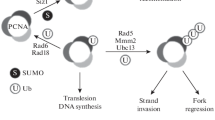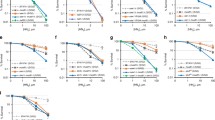Abstract
Thepso4-1 mutant was characterized as deficient in some types of recombination, including gene conversion, crossing over, and intrachromosomal recombination. The mode of interaction betweenpso4-1 andrad51 and betweenpso4-1 andrad52 mutants indicated that thePSO4 gene belongs to theRAD52 epistasis group for strand-break repair. Moreover, the presence of thepso4-1 mutation decreased 8-MOP-photoinduced mutagenesis of therad51 andrad52 mutants. Complementation tests using heterozygous diploid strains showed that thePso4 protein might interact with theRad52 protein during repair of 8-MOP photolesions. Thepso4-1 mutant, even though defective in inter- and intea-chromosomal recombination, conserves the ability for plasmid integration of circular and linear plasmid DNA. On the other hand, similar to therad51 mutant,pso4-1 was able to incise but did not restore high-molecular-weight DNA during the repair of cross links induced by 8-MOP plus UVA. These results, together with those of previous reports, indicate that thePSO4 gene belongs to theRAD52 DNA repair group and its product participates in the DNA rejoining step of the repair of cross-link lesions, which are crucial for induced mutagenesis and recombinogenesis.
Similar content being viewed by others
References
Andrade HHR, Marques EK, Schenberg ACG, Henriques JAP (1989) The PSO4 gene is responsible for an error-prone recombinational DNA repair pathway inSaccharomyces cerevisiae. Mol Gen Genet 217:419–426
Armstrong JD, Chadee DN, Kunz BA (1994) Role for the yeast RAD18 and RAD52 DNA repair genes in UV mutagenesis. Mutat Res 315:281–293
Averbeck D, Dardalhon M, Magaña-Schwencke N, Meira LB, Meniel V (1992) New aspects of the repair and genotoxic of psoralen photoinduced lesions in DNA. J Photochem Photobiol B: Biol 4:4763
Benathen A, Beam CA (1977) The genetic control of X-ray resistance of budding yeast cells. Radiat Res 69:91–116
Borstel RC von, Quah S-K, Steinberg CM, Fleury F, Gottlieb DJC (1973) Mutant of yeast with enhanced spontaneous mutation rates. Genetics (suppl) 73:141
Chow TYK, Resnick MA (1988) An endo-exonuclease activity of yeast that requires a functional RAD52 gene. Mol Gen Genet 211:41–48
Donovan JW, Milne GT, Weaver DT (1994) Homotypic and heterotypic protein association control Rad51 function in doublestrand break repair. Genes Dev 8:2552–2562
Dornfeld KJ, Livingston DM (1992) Plasmid recombination inrad52 mutant ofSaccharomyces cerevisiae. Genetics 131:261–276
Friedberg EC (1988) Deoxyribonucleic acid repair in the yeastSaccharomyces cerevisiae. Microbiol Rev 52:70–102
Friedberg EC, Siede W, Cooper AJ (1991) Cellular response to DNA damage in yeast. In: Broach JW, Pringle JR, Jones EW (eds.) The molecular and cellular biology of the yeastSaccharomyces: genome dynamics, protein synthesis and energetics. Cold Spring Harbor Laboratory, Cold Spring Harbor, New York, pp 147–192
Game JC (1983) Radiation-sensitive mutants and repair in yeast. In: Spencer JET, Spencer MD, Smith ARW (eds.) Yeast genetics: fundamental and applied aspects. Spring-Verlag, New York, pp 109–137
Henriques JAP, Brendel M (1990) The role of PSO and SNM genes in DNA repair of the yeastSaccharomyces cervisiae. Curr Genet 18:387–393
Henriques JAP, Vicente EJ, da Silva KVCL, Schenberg ACG (1989) PSO4: a novel gene involved in error-prone repair inSaccharomyces cerevisiae. Mutat Res 218:111–124
Jachymczyk WJ, von Borstel RC, Mowat MRA, Hastings PJ (1981) Repair of interstrand cross-links in DNA ofSaccharomyces cerevisiae requires two systems for DNA repair: The RAD3 system and the RAD51 system. Mol Gen Genet 182:196–205
Kadyk LC, Hartwell LH (1992) Sister chromatids are preferred over homologs as substrates for recombinational repair inSaccharomyces cerevisiae. Genetics 132:387–402
Magaña-Schwencke N, Henriques JAP, Chanet R, Moustacchi E (1982) The fate of 8-metoxypsoralen photoinduced crosslinks in nuclear and mitochondrial yeast DNA: comparison of wild-type and repair-deficient strains. Proc Natl Acad Sci USA 79:1222–1226
Meira LB, Fonseca MB, Averbeck D, Schenberg ACG, Henriques JAP (1992) Thepso4-1 mutation reduces spontaneous mitotic gene conversion and reciprocal recombination inSaccharomyces cerevisiae. Mol Gen Genet 235:311–316
Milne G, Weaver D (1993) Dominant negative alleles of RAD52 reveal DNA repair/recombination complex including Rad51 and Rad52. Genes Dev 7:1755–1765
Morais Jr MA, Brozmanova J, Benfato MS, Duraj J, Vlckova V, Henriques JAP (1994) TheE. coli recA gene can restore the defect in mutagenesis of the mutantpso4-1 ofS. cerevisiae. Mutat Res 314:209–220
Ogawa T, Yu X, Shinohara A, Egelman EH (1993) Similarity of the yeast Rad51 filament to the bacterial RecA filament. Science 259:1896–1899
Orr-Weaver TL, Szostak JW (1983) Yeast recombination: the association between double-strand gap repair and crossing-over. Proc Natl Acad Sci USA 80:4417–4421
Orr-Weaver TL, Szostak JW, Rothstein RJ (1981) Yeast transformation: a model system for the study of recombination. Proc Natl Acad Sci USA 78:6354–6358
Perera JR, Glasunov AV, Glacer VM, Boreiko AV (1988) Repair of double-strand breaks in plasmid DNA in the yeastSaccharomyces cerevisiae. Mol Gen Genet 213:421–424
Petes TD, Malone RE, Symington LS (1991) Recombination in yeast. In: Broach JW, Pringle JR, Jones EW (eds.) the molecular and cellular biology of the yeastSaccharomyces: genome dynamics, protein synthesis and energetics. Cold Spring Harbor Laboratory, Cold Spring Harbor, New York, pp 407–512
Rattray AJ, Symington LS (1994) Use of a chromosomal inverted repeat to demonstrate that the RAD51 and RAD52 genes ofSaccharomyces cerevisiae have different roles in mitotic recombination. Genetics 138:587–595
Rose MD, Winston F, Hieter P (1990) Methods in yeast genetics: a laboratory manual, Cold Spring Harbor Laboratory Press, Cold Spring Harbor, New York
Rothstein R (1991) Guide to yeast genetic and molecular biology. Methods Enzymol 194:281
Sambrook J, Fritsch EF, Maniatis T (1989) Molecular cloning: a laboratory manual, 2nd edn. Cold Spring Laboratory, Cold Spring Harbor, New York
Schiestl RH, Geitz RD (1989) High-efficiency transformation of intact yeast cells by using single-stranded nucleic acid as a carrier. Curr Genet 16:339–346
Schiestl RH, Petes TD (1991) Integration of DNA fragments by illegitimate recombination inSaccharomyces cerevisiae. Proc Natl Acad Sci USA 88:7585–7589
Shinohara A, Ogawa H, Ogawa T (1992) Rad51 protein involved in repair and recombination inS. cerevisiae is a RecA-like protein. Cell 69:457–470
Silva KVCL da, Andrade HHR, Henriques JAP (1990) Mutational response of a diploidpso4-1 yeast strain defective in error-prone recombinational DNA repair. Brazil J Genet 13:393–408
Silva KVCL da, Morais Jr MA, Henriques JAP (1995) The PSO4 gene ofS. cerevisiae is important for sporulation and the meiotic DNA repair of photoactivated psoralen lesions. Curr Genet 27:207–212
Story RM, Bishop DK, Klecner N, Steitz TA (1993) Structural relationship of bacterial RecA proteins to recombination proteins from bacteriophage T4 and yeast. Science 259:1892–1896
Sung P (1994) Catalysis of ATP-dependent homologous DNA pairing and strand exchange by yeast Rad51 protein. Science 265:1241–1243
Author information
Authors and Affiliations
Additional information
Communicated by K. Wolf
Rights and permissions
About this article
Cite this article
de Morais, M.A., Vicente, E.J., Brozmanova, J. et al. Further characterization of the yeastpso4-1 mutant: interaction withrad51 andrad52 mutants after photoinduced psoralen lesions. Curr Genet 29, 211–218 (1996). https://doi.org/10.1007/BF02221550
Received:
Issue Date:
DOI: https://doi.org/10.1007/BF02221550




